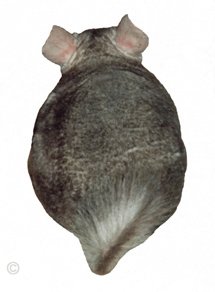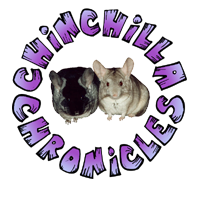 Every three months a chinchilla will shed its fur, this sounds more alarming than it actually is. Chinchilla fur is released slowly just like we loose hair strands on a daily basis. The difference is chinchillas shed a lot of fur due to them having so many hairs per follicle. On average humans have three hairs per follicle, whereas a chinchilla has up to eighty hairs per follicle, hence a lot of fur being shed.
Every three months a chinchilla will shed its fur, this sounds more alarming than it actually is. Chinchilla fur is released slowly just like we loose hair strands on a daily basis. The difference is chinchillas shed a lot of fur due to them having so many hairs per follicle. On average humans have three hairs per follicle, whereas a chinchilla has up to eighty hairs per follicle, hence a lot of fur being shed.
Shedding of chinchilla fur is perfectly normal and also serves another purpose of keeping the fur in the best possible condition.
The new fur growth typically begins at the head and works its way down the back and sides ending at the tail. This new fur growth pushes up through the old hair follicles and expresses itself as a distinct line, which is known as the 'Priming Line'. This line distinguishes the old growth from the new. When the 'priming line' reaches a chinchilla's tail, a chinchilla's coat is considered to be in its prime condition, hence the name 'Priming Line'.
You may not always notice a distinct priming line on a chinchilla as they all shed individually. Some look like they have loose fur strands falling out all over their coat whilst others have a completely visible priming line.
Chinchillas all shed fur at different rates so don't be alarmed if one starts shedding again before the old priming line has disappeared down the tail. Both genetic and weather factors have an impact on a chinchilla's shedding cycle and you may notice a chinchilla starts shedding old growth quicker during warmer climates.
The shedding period usually lasts approximately two weeks and a chinchilla will remain in its prime condition (best coat condition) for several weeks during this time, after which, the shedding and new growth cycle will begin again.
Shedding should not be confused with Fur Slip, which is an entirely different condition altogether.
CHINCHILLA GROOMING
During the time a chinchilla is shedding it is paramount you keep the cage clean and fur free, you can also groom a chinchilla during the time it is shedding but it really is not necessary and not done in the wild.
Grooming of chinchillas is mainly done by breeders entering chinchillas into shows and is done to enhance the appearance of the chinchilla's coat.
If you wish to try and groom a chinchilla, it must be done with care as to not pull out any chinchilla fur that is not ready to be shed. Fine toothed combs are also very sharp and care must be taken to not scratch a chinchilla as they wriggle around.
You will not be able to groom a chinchilla if your pet is not happy with being handled, therefore taming a chinchilla is necessary in the first place.
A chinchilla will generally groom itself but if you feel you would like to try grooming a chinchilla, time and patience will be needed as you both get used to the process.
Never groom a chinchilla directly after a dust bath as the comb can catch on any dust left and potentially rip out healthy fur. It is wise to stop the dust baths for a couple of days before grooming to ensure any clumps of dust have fallen out of the chinchilla's fur. If you choose to groom a chinchilla, do so before offering a dust bath, as this will help the dust penetrate deeper into the fur, which helps reach the skin better.
For a complete job, you will need two sets of combs for grooming, a 'medium toothed' comb and a 'fine toothed' comb. The first comb to use is a 'medium toothed comb'. This grooming comb has larger gaps and helps to remove any loose fur as well as untangling any fur that has become slightly matted. The 'fine toothed comb' is generally used on 'show' chinchillas to help finish the grooming job and is not necessary to be used on a standard pet chinchilla.
Steady a chinchilla over a towel on your lap, either by holding the chinchilla by the base of the tail (the part that's near the body and not the tip!) or place a hand in front of the chest and wait until the chinchilla has calmed and remains still.
Starting at the rear (using a medium toothed comb) gently separate and comb small sections only. Be very careful that you don't accidentally scratch the chinchilla's skin, which can cause inflammation. Continue in small sections and work up the back and sides until you have reached the neck - you do not need to groom a chinchilla's face!
You can groom a chinchilla's underbelly but this is much easier said than done as they are not keen on lying on their back and staying still for long. If you choose to do so, work in small sections like before.
You can repeat the whole grooming process again using a fine toothed comb to further loosen dead fur but only do this if the chinchilla is really enjoying it!
WARNING - If you notice clumps of un-groomed fur around the back of a chinchilla's thighs, this is one of the symptoms of an underlying Tooth Disorder and you must take the chinchilla to a vet immediately for a dental examination.
CHINCHILLA DUST BATHS
 If you didn't already know, chinchillas bathe in volcanic ash and not water. A chinchilla dust bath serves an important purpose as a replacement for volcanic ash and has been made especially for chinchillas - it is light grey in colour and extremely fine in texture.
If you didn't already know, chinchillas bathe in volcanic ash and not water. A chinchilla dust bath serves an important purpose as a replacement for volcanic ash and has been made especially for chinchillas - it is light grey in colour and extremely fine in texture.
This type of 'dust' acts as a 'fur cleaning agent' and helps keep the chinchilla's coat clean thus preventing skin disorders and other infections. The dust sticks to oils and dirt, which has accumulated within the chinchilla's fur and clumps around it making it easier to fall off.
Without a regular dust bath the oils, which have secreted from the chinchilla's skin, will accumulate on the skin surface collecting dirt, which in turn can cause skin disorders and make the chinchilla's coat oily/greasy.
You should provide a chinchilla dust bath daily for 5-10 minutes or at least every other day especially in hot humid conditions. Their bath should be at least 2" deep and contained within a tin big enough for a chinchilla to roll around in freely.
A couple of precautions should be maintained whilst providing a chinchilla a dust bath:
- Keep a regular check on the chinchilla's skin condition and should it be showing symptoms of dryness or redness, change the brand of dust bath you provide and/or reduce the amount of times you offer the bath.
- If a dust bath is left for a period of time, a chinchilla will urinate in it marking his territory and begin using it as a toilet.
You can reuse a dust bath providing a chinchilla has not urinated in it - if this has happened, it will need to be disregarded and replaced with new.
Once a chinchilla has finished using its dust bath, using a fine sieve, pour the sand through and remove any droppings or other debris. The sand is then ok to use again - replace old dust with new on every third recycle. If you keep reusing the same dust over time dead skin cells accumulate within the dust and will start to cause skin and fur disorders.
WARNING - It is known if a chinchilla is not given a dust bath for long enough, they will become out of the habit and will not choose to bathe again.
The act of rolling around in a dust bath is learnt from birth via mother to kit. If a chinchilla chooses not to bathe in dust, it has either not had a dust bath in a long time (and has lost the habit of grooming in this way) or the process has not been taught from mother to kit. This could be due to the mother not been given dust baths regularly to demonstrate the bathing action or the kit was removed from its mother before it could learn the skill.
Should a chinchilla stop grooming you can entice them back and teach them what to do by administering a Manual Dust Bath daily.
Place a towel with some chinchilla dust on your lap and position the chinchilla on top. Rub some sand into your hands and gently stroke the chinchilla and get him used to the smell. You can also scatter some sand onto the floor as generally when a chinchilla comes across the dust, they stops to have a quick roll. If this fails, put some sand deep enough into a big container, which a chinchilla can jump into and leave it in the middle of the floor. A chinchilla's curiosity will at some point cause him to jump in and if the sand is deep enough you will find they will generally have a sniff around and begin to get used to it again.
Further Reading Relating To Chinchilla Shedding & Grooming:
Holding A Chinchilla.


 Every three months a chinchilla will shed its fur, this sounds more alarming than it actually is. Chinchilla fur is released slowly just like we loose hair strands on a daily basis. The difference is chinchillas shed a lot of fur due to them having so many hairs per follicle. On average humans have three hairs per follicle, whereas a chinchilla has up to eighty hairs per follicle, hence a lot of fur being shed.
Every three months a chinchilla will shed its fur, this sounds more alarming than it actually is. Chinchilla fur is released slowly just like we loose hair strands on a daily basis. The difference is chinchillas shed a lot of fur due to them having so many hairs per follicle. On average humans have three hairs per follicle, whereas a chinchilla has up to eighty hairs per follicle, hence a lot of fur being shed. If you didn't already know, chinchillas bathe in volcanic ash and not water. A chinchilla dust bath serves an important purpose as a replacement for volcanic ash and has been made especially for chinchillas - it is light grey in colour and extremely fine in texture.
If you didn't already know, chinchillas bathe in volcanic ash and not water. A chinchilla dust bath serves an important purpose as a replacement for volcanic ash and has been made especially for chinchillas - it is light grey in colour and extremely fine in texture.